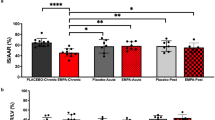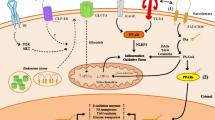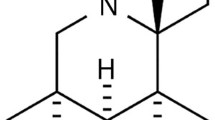Abstract
Diabetics suffer from an increased incidence of myocardial infarction and are less likely to survive an ischemic insult. Since L-propionylcarnitine (LPC) has been shown to protect against ischemic/reperfusion injury, we hypothesized that LPC may be of even greater benefit to the diabetic heart. Diabetes was induced by i.v. streptozotocin, 60 mg/kg; duration: 12 wks. The chronic effect of LPC was determined by daily i.p. injections (100 mg/kg) for 8 wks. The acute effects of LPC were determined by adding it to the perfusion medium (5 mM) of control and diabetic hearts. Initial cardiac contractile performance of isolated perfused working hearts was assessed by varying left atrial filling pressure. Hearts were then subjected to 90 min of low flow global ischemia followed by 30 min reperfusion. Chronic LPC treatment had no effect on initial cardiac performance in either control or diabetic hearts. Acute addition of LPC to the perfusion medium enhanced pump performance of control hearts, but had no effect in diabetic hearts. Both acute and chronic LPC significantly improved the ability of control and diabetic hearts to recover cardiac contractile performance after ischemia and reperfusion, however, chronic treatment was more effective in diabetic hearts.
Similar content being viewed by others
References
Barrett-Connor EL, Cohn BA, Wingard DL, Edelstein SL: Why is diabetes mellitus a stronger risk factor for fatal ischemic heart disease in women than in men? The Rancho Bernardo Study. JAMA 265: 627–631, 1991
Assmann G, Schulte H: Diabetes mellitus and hypertension in the elderly: Concomitant hyperlipidemia and coronary heart disease risk. Am J Cardiol 63: 33H-37H, 1989
Henning R, Lundman T: Swedish cooperative CCV study: a study of 2009 patients with acute myocardial infarction from twelve Swedish hospitals with coronary care units. I: A description of the early stage. ACTA Med Scand 198: 1–64, 1975
Kotler TS, Diamond GA: Myocardial ischemia in diabetic patients. Ann Intern Med 109: 678–678, 1988
Kannel WB: Role of diabetes in cardiac disease: conclusions from population studies. In: S Zonaraich (ed.) Diabetes and the Heart. Thomas, Springfield, IL, 1978, pp. 97–112
Hearse DJ, Steward DA, Green DG: Diabetes and the survival and recovery of the anoxic myocardium. J Mol Cell Cardiol 7: 397–415, 1975
Hearse DJ, Steward DA, Green DG: Myocardial susceptibility to ischemic damage: a comparative study of disease models of rats. Eur J Cardiol 75: 437–450, 1978
Ingebretsen CG, Moreau P, Hawelu-Johnson C, Ingebretsen WR: Performance of diabetic rat hearts: effects of anoxia and increased work. Am J Physiol 239: H614-H620, 1980
Paulson DJ, Kopp SJ, Peace DG, Tow JP: Improved postischemic recovery of cardiac pump function in exercised trained diabetic rats. J Appl Physiol 65: 187–193, 1988
Pieper GM, Gross GJ: Diabetes alters postischemic response to a prostacyclin mimetic. Am J Physiol 256: H1353-H1360, 1989
Feuvray D, Idell-Wenger JA, Neely JR: Effects of ischemia on rat myocardial function and metabolism in diabetes. Am J Physiol 44: 322–329, 1979
Khandoudi N, Bernard M, Cozzone PA, Feuvray D: Intracellular pH and role of Na/H exchange during ischaemia and reperfusion on normal and diabetic rat hearts. Cardiovasc Res 24: 873–878, 1980
Tani M, Neely JR: Hearts from diabetic rats are more resistant toin vitro ischemia: possible role of altered calcium metabolism. Circ Res 62: 931–940, 1988
Paulson DJ, Traxler J, Schmidt M, Noonan J, Shug AL: Protection of the ischaemic myocardium by L-propionylcarnitine: effects on the recovery of cardiac output after ischaemia and reperfusion, carnitine transport and fatty acid oxidation. Cardiovasc Res 20: 536–541, 1986
Liedtke AJ, DeMaison L, Nellis SH: Effects of L-propionylcarnitine on mechanical recovery during reflow in intact hearts. Am J Physiol 255: H169-H176, 1988
Ferrari R, Ceconi C, Curello S, Pasini E, Visioli O: Protective effect of propionyl-L-carnitine against ischaemia and reperfusion-damage. Mol Cell Biochem 88: 161–168, 1989
Di Lisa F, Menabò R, Siliprandi N: L-Propionyl-carnitine protection of mitochondria in ischemic rat hearts. Mol Cell Biochem 88: 169–173, 1989
Leasure JE, Kordenat K: Effect of propionyl-L-carnitine on experimental myocardial infarction in dogs. Cardiovasc Drugs Ther 5 Suppl 1: 85–96, 1991
Aomine M, Nobe S, Arita M: Electrophysiologic effects of a short-chain acyl carnitine, L-propionylcarnitine, on isolated canine Purkinje fibers. J Cardiovasc Pharmacol 13: 494–501, 1989
Aomine M, Arita M: Differential effects of L-propionylcarnitine on the electrical and mechanical properties of Guinea pig ventricular muscle in normal and acidic conditions. J Electrocardiol 20: 287–296, 1987
Aomine M, Arita M, Shimada T: Effects of L-propionylcarnitine on electrical and mechanical alterations induced by amphiphilic lipids in isolated Guinea pig ventricular muscle. Heart Vessel 4: 197–206, 1988
Di Biase M, Tritto M, Pitzalis MV, Favale S, Rizzon P: Electrophysiological evaluation of intravenous L-propionylcarnitine in man. Int J Cardiol 30: 329–333, 1991
Siliprandi N, Di Lisa F, Menabò R: Propionyl-L-carnitine: Biochemical significance and possible role in cardiac metabolism. Cardiovasc Drugs Ther 5 Suppl 1: 11–16, 1991
Hülsmann WC: Biochemical profile of propionyl-L-carnitine. Cardiovasc Drugs Ther 5 Suppl 1: 7–10, 1991
Wall SR, Lopaschuk GD: Glucose oxidation rates in fatty acidperfused isolated working hearts from diabetic rats. Biochim Biophys Acta 1006: 97–103, 1989
Vary TC, Neely JC: A mechanism for reduced myocardial carnitine levels in diabetic animals. Am J Physiol 243: H154-H158, 1982
Shug A, Paulson D, Subramanian R, Regitz V: Protective effects of propionyl-L-carnitine during ischemia and reperfusion. Cardiovasc Drugs Ther 5 Suppl 1: 77–84, 1991
Packer L, Valenza M, Serbinova E, Starke-Reed P, Frost K, Kagan V: Free radical scavenging is involved in the protective effect of L-propionyl-carnitine against ischemia-reperfusion injury of the heart. Arch Biochem Biophys 288: 533–537, 1991
Randle PJ: Fuel selection in animals. Biochem Soc Trans 14: 799–806, 1986
Paulson DJ, Schmidt MJ, Traxler JS, Ramacci MT, Shug AL: Improvement of myocardial function in diabetic rats after treatment with L-carnitine. Metabolism 33: 358–363, 1984
Paulson DJ, Kopp SJ, Peace DG, Tow JP: Myocardial adaptation to endurance exercise training in diabetic rats. Am J Physiol 252: R1073-R1081, 1987
Pierce GN, Ramjiawan B, Dhalla NS, Ferrari R: Na1-H+ exchange in cardiac sarcolemmal vesicles isolated from diabetic rats. Am J Physiol 258: H255-H261, 1990
Author information
Authors and Affiliations
Rights and permissions
About this article
Cite this article
Paulson, D.J., Shug, A.L. & Zhao, J. Protection of the ischemic diabetic heart by L-propionylcarnitine therapy. Mol Cell Biochem 116, 131–137 (1992). https://doi.org/10.1007/BF01270580
Issue Date:
DOI: https://doi.org/10.1007/BF01270580




